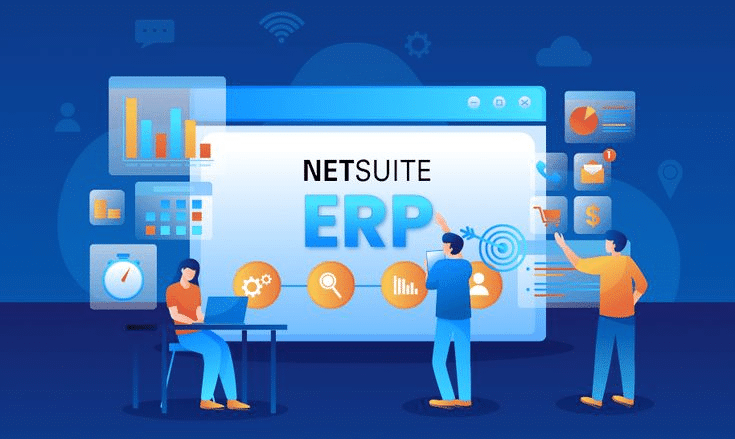Introduction
Are you up for a change? Let us start the journey of growth with NetSuite. In our newest detailed guide, we share the best practices of a flawless NetSuite implementation to increase your organizational performance from the start. So, whether you’re considering how to start a business analysis upwards to realize simple, effective configuration and efficient data migration, this post has you covered. Now let’s turn our attention towards the various solution pathways that may assist you maximize your ERP’s potential.
NetSuite is one of today’s popular and most powerful cloud-based ERP solutions, and it is for a reason. While you may be from the professional service industry or healthcare industry, the manufacturing industry, or the private equity industry, getting it right could make a huge difference to your business.
In this blog, we will walk you through the leading steps involved from identifying the requirements of the business to migration and configuration of Netsuite. By the end of this article you should have got an understanding of how this great system can increase your productivity right from the start.
Starting the Implementation Process: Key Steps
When a business is ready to implement NetSuite, the first step is understanding the business itself. It’s crucial to come in with a clear mind and, as one expert put it, to “walk stupid”—to listen to the business with “ears wide open” without preconceived notions. Every company is unique, and NetSuite implementation begins by assessing the business from the ground up through open communication with key stakeholders.
The implementation team brings in a set of templates to validate existing processes. The goal is not just to introduce a new system but to ensure the solution fits the company’s needs. This involves asking detailed questions and engaging in a bit of process re-engineering—identifying gaps in the current system and discovering how NetSuite can fill those gaps.
Process Re-Engineering: Identifying Gaps and Improvements
Process re-engineering is all about analyzing the current workflow. The implementation team collaborates with the business to outline the best approach. Often, diagrams of ideal practices are already drawn out, but the team works to understand if they are the right fit.
Once they have a comprehensive overview of the business requirements, they focus on key areas like employee roles, key performance indicators (KPIs), and what is truly important to the business. This analysis helps tailor the implementation to provide immediate value from the start.
Configuring NetSuite: Sandbox vs. Production
One of the key parts of NetSuite implementation is that it has to be adapted to the needs of the certain business. Usually, this occurs in the test environment that is referred to as the sandbox environment. In the sandbox, core configurations are made and tested before they are rolled out into the production environment.
This process is iterative, involving constant feedback from the client. Open communication is vital here. While the implementation team handles the heavy lifting, the client plays an active role in refining configuration rules. This ensures that the system evolves in a way that aligns with the company’s operations.
Data Migration Strategy: Cleaning and Managing Data
No implementation is complete without addressing data migration. Often businesses end up with something known as ‘Dirty data’ and what this refers to is that the data is current, yet it is bad data or maybe contains some level of data missing. The group discusses how to differentiate customers’ information, vendors’ information, as well as the employees’ information in the NetSuite implementation project.
Are there outdated customers in the system? Are credit approval limits in place? How is employee data handled? These are the types of questions asked during data migration. It is high time that all businesses took the time and cleaned up their data and enhanced their interaction with their customers and vendors.
Enhancing Customer Experience with Data Quality Controls
As the data is migrated, quality controls are introduced to ensure that it remains clean and accurate going forward. Employees are trained on how to maintain data quality, and the system’s role-based security ensures that everyone has access only to the information they need.
For businesses that handle sensitive information, such as employee data, NetSuite’s powerful HR module offers privacy controls that protect data while integrating with third-party payroll systems. This way, businesses can manage their human resources efficiently while maintaining privacy and security.
Integrating NetSuite with Payroll and HR Systems
In the U.S., NetSuite offers its own payroll solution. However, for companies using third-party solutions, integration is seamless through APIs or CSV loaders. This ensures that all employee data, including payroll and performance metrics, is centralized within the NetSuite platform.
This centralization offers businesses a unified view of their employee costs, performance, and other key metrics, helping them make better decisions and optimize workflows.
How NetSuite Solves Business Problems Across Industries
Each business is different, but the problems that accompany their work are the same problems. Whether it is multi-site management, dealing with big amounts of data or enhancing operational performance NetSuite provides tools for these purposes.
Many companies today, including law firms, accounting firms and even warehousing companies have adopted NetSuite for their operations. From real time financial visibility to improved supply chain management, the system offers solutions for major business issues.
QuickBooks’ Desktop to NetSuite Migration
Any business currently utilizing QuickBooks Desktop that will reach its end-of-life should consider migrating to NetSuite. Many QuickBooks users report that with NetSuite you get a broader product that can be expanded upon and is more efficient. This frustration will make NetSuite a welcomed platform for those that were working on outdated systems.
Other organizations that are aligned with NetSuite as their ERP system but experiencing service performance issues are also encouraged to come back to configure. They have preferred solutions that can significantly enhance the service, result, and even get a better price for NetSuite licensing.
Conclusion: Why NetSuite is the Right Choice
One of the key benefits that NetSuite provides to businesses is the capability for businesses to adapt it for a range of processes, improve consolidation and enhance efficiency from the initial stages of implementation. This implementation process can be done through iterations to fit your specific needs, and the system protects accuracy and security with data controls and access rights by role.
For those who are planning to migrate to NetSuite, or for those who are already using NetSuite and desire more positive results, don’t just sit back and watch. ORG is ready to answer all of your questions, so schedule a consultation now to find out how NetSuite can revolutionize your company.

